Los Angeles is known for its malls in a way almost no other major city is. Its urban built environment is proto-suburban, an odd blend of almost-urban density and car-culture all blended into a stew. So unlike other large cities, where malls feel like something of an afterthought, grafted onto the edges of cities at a beltway, Los Angeles is a place where they feel purposefully like hubs within the urban fabric.
The west end of Los Angeles is this sprawling city’s most famous swath–the ten or so miles from the beach in Santa Monica to downtown Los Angeles are home to a jumble of infamous neighborhoods, including Hollywood and Beverly Hills. As you might expect with names such as these, it’s a fashionable and affluent stretch of the city, home to multiple malls and miles of street-front retail.
The Beverly Center is something of a monolith at La Cienega and San Vicente Boulevards, between West Hollywood and Beverly Hills (both actually separate cities from LA itself, but totally surrounded by it). From the outside, the mall is positively gargantuan, standing well above all surrounding structures and visible for miles down Beverly Blvd. The center is organized in an odd fashion, with a six story parking garage beginning at ground level and leading up to the mall, which is perched atop the large structure. In actuality, this is horrendous urban form; instead of interfacing with the street and surrounding neighborhood, the mall is above its surroundings as if a massive luxury penthouse.
Opened in 1982, the Beverly Center was developed by legendary mall developer A. Alfred Taubman and replaced a small old amusement park on the site. The mall’s vaulted structure–criticized earlier–does serve a purpose: there’s oil underneath the mall, and the structure of the center allows for an enclosure for active oil wells underneath a portion of the property. Originally anchored by Bullock’s and The Broadway along with a movie theatre, the Beverly Center was also home to the first U.S. location of the Hard Rock Cafe. Today, mall itself is an attractive blend of upscale stores, anchored by Bloomingdale’s and Macy’s (both of which replaced the original anchors after they were absorbed into Federated in the mid 90s). The theatres which opened with the mall in 1982 just closed this month; they were open at the time my photos were taken in March of 2010. The three-level mall is somewhat austere and ’80s modern (with updates, of course), but it earns some significant points from me for its almost total lack of kiosks and its hotel-style center court bar, both of which lend to the un-harried ambiance.
Also, due to its location, the Beverly Center has unsurprisingly been mentioned in a ton of movies, books, songs, and whatever else, plus it has served as a spot for B list (and lower…) celebrities to take part-time retail jobs while waiting for work. Case in point: Danny Pintauro of “Who’s The Boss” apparently worked at The Gap for awhile. Don’t remember Danny Pintauro? That’s why he was working at The Gap!

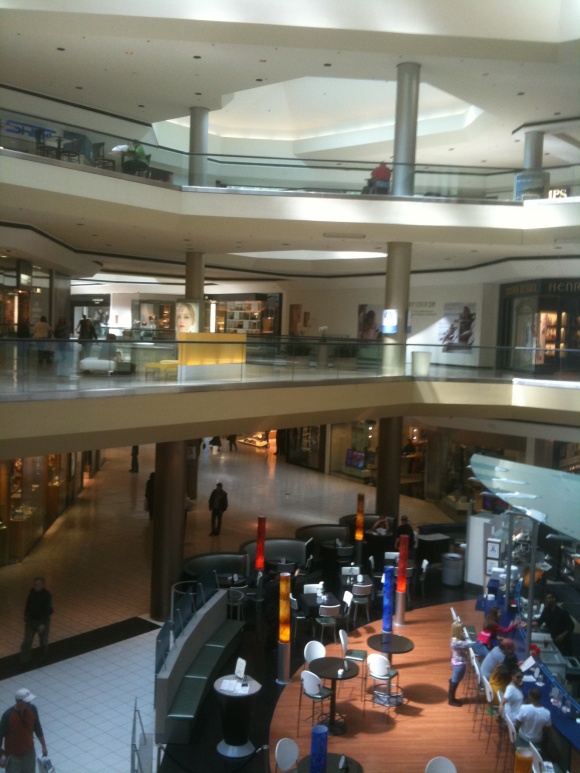

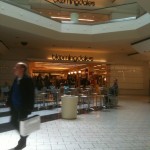
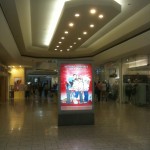
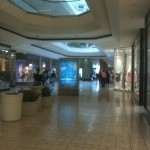
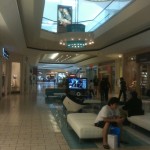
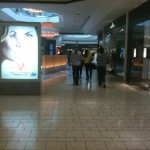
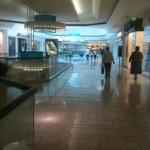
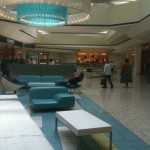
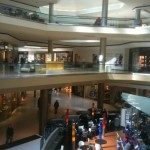
Hollywood is hardly affluent. It’s been struggling since the end of WWII from one redevelopment scheme to another.
Beverly Center is probably the weakest mall in West LA area. Much of its market area is middle income at best (e.g., Fairfax). It competes with the glitzier “The Grove” lifestyle center which is practically next door as well as flashier places like Century City which is better situated to get affluent customers, not to mention Rodeo Drive. The parking garage/penthouse design is an odd one and makes it annoying to enter the place. My recollection is a lackluster roster of stores and lackluster anchors. Beverly is a B-list mall for B-list movies.
LA proper has malls that came later to the existing fabric, like Century, Beverly, and Westside Galleria, but it also has conventional malls like Topanga and typical 50s strips like Panorama City. LA was built as a streetcar city and this includes the first ring of suburbs, including places that developed after WWII like Arcadia. Despite its lack of historical conciousness, it has done less to wreck its urban fabric than say, Atlanta. It has a downtown that, through neglect, is loaded with early 20th century architecture. Given its carbound rep, LA is, ironically, the one sunbelt city that could easily redevelop into an urban place and it actually supports many walking commercial areas.
Southern California malls are definitely unique in terms of design and layout. The Beverly Center falls into this category.
My favorite is Southern California mall is Fashion Valley in the Mission Valley neighborhood of San Diego
Did have cooler 80s decor back in the day?
Even with all the nearby competition and funky early ’80s design, this is still a very interesting mall. Even the updates are rather tasteful, though it could use some greenery.
Let’s not forget, Beverly Center is a Taubman mall. The malls which were built by Taubman from the ground up were all built alike…same marble flooring, similar skylights, ceiling design and use of glass and chrome. Short Hills, Fair Oaks, Stamford Town Center, Westfarms and McArthur Center all look alike.
My all time fav LA Mall (and I been to them all has got to be the Westside Pavilion. Especially now with the new art movie theater. From the top of the parking garage you can see Hollywood & downtown.
The theatres originally opened as a Cineplex Odeon. When Cineplex & loews merged in 1998, this location was sold to Mann Theatres. More recently it was opperated I believe by Rave Motion Pictures.
There is a Grand Luxe Cafe on the street level as well as Bed Bath & Beyond.
I drove past the mall & couldn’t believe the massiveness of the structure. reading about it is one thing, but seeing it in front of you & recognizing it is another
@SEAN, Edited from Cinema Tour web site.
Beverly Center 13 Cinema
8522 Beverly Blvd #835
Beverly Grove (Los Angeles) CA 90048
Opened: July 16, 1982
Closed: June 3, 2010
Current Use:
Demolished: Capacity:
Previously operated by: Cineplex Theatres, Cineplex Odeon Theatres, Loews-Cineplex Theatres, Mann Theatres, Rave Motion Pictures
The opening of the Beverly Center featured a 14-screen movie theater operated by Cineplex. At the time, the theater contained the largest number of screens in one complex in the US. Three small screens on the main floor were closed in the late 1980s and replaced with two larger auditoriums on the upper level.
Mann closed the Beverly Center Cinemas on August 6, 2009. It was reopened on September 4 by Rave Digital Media, which is affiliated with Rave Motion Pictures.
The theater closed again on June 3, 2010, to be replaced by retail space.
@mallguy, Never been to Fashon Valley, but have sene it on youtube. I must say it’s got to be one of the best designed malls out there.
I’ve visited South Coast Plaza in Coasta Mesa in 2005 before Bloomingdale’s opened, & let me tell you, now that’s a mall!
The Grove @ Farmers Market isn’t a slouch by any means either. Infact I visited three times in one week & noticed that even on a weeknight it got busier as the night war on. Is there a mall like that around metro New York? Palasades Center perhaps, but it pails in comparison to the Grove.
One correction about the theaters.. Two 200 seat theaters were torn out for two large theaters with balconies. The third and fourth auditoriums were merged together to form a larger cinema three..
I took over 200 pictures of the theater closing night that are posted in the cinematour pages.
I just checked the driving distance from Century City Shopping Center to Beverly Center & BC is only 2.9 miles to the southeast.
Interesting that Macy*s & Bloomingdale’s anchor both centers, although Century City has an AMC theatre as part of the center.
@Eric Fresh, On a clear day, that must be some view into the hills.
I saw one movie at Beverly Center in the mid-1980’s. It had to be the smallest screen I ever watched a movie on.
I really love the architecture and style of this mall, and will visit even though I generally dislike all shopping centers. I also found a nifty app for iPhone users that has a complete layout and gives directions on how to navigate the mall. it’s called FastMall.
The theater is being taken over by Forever 21. Remember seeing “Without You I’m Nothing” and “Long Time Companion” there while in high school. Ahh…the memories.
@SEAN,
In addition to Fashion Valley, I also think Horton Plaza (in the Gaslamp in San Diego) is quite the mall!
In Orange County, I have not been to South Coast Plaza, I have seen picsof it, and wow! I have been to Irvine Spectrum Center, which is also very well designed!
@SEAN,
And because it’s Southern California, they’ll likely be driving between the two as opposed to walking, lol.
I’ll bet you are right on that one. Haha!
Although I do like the Grove. Where else can you get fresh fruits & veggies as well as a suit from Nordstrom at the same time? Only in L A. LOL
You have to profile South Coast Plaza…it’s an amazing place.
The one trend in malls that saddens me is the death of the mall bookstore. Granted that with the growth of B&N and Borders in freestanding (non-mall) locations it’s hard to justify the little mall-based bookstores. I loved them, though, because you could always pop in there and get a magazine or even a book. Now its hard to even find a newspaper in a million plus square foot mall!
Long ago South Coast Plaza had a cool bookstore called Brentano’s. The store had a lot of art books and foreign books…its long since gone.
Saw movies there many times when I lived just off Melrose Avenue in the early Nineties. I recall seeing David Bowie and Iman coming out of another theatre as I was.
The small autditoriums in this complex were THE smallest I have ever seen or been in. I saw “Spirit of ’76” in one of those. It was the size of one of those home screening rooms that people have in their large mansions. I think I remember acutally counting the seats because I couldn’t believe how small it was. It think it had 30 seats! (4 rows of 8 seats, with 2 removed for wheelchair access.)
Must have been the same vibe as those small “storefront” porno theaters that existed in 1960’s and 70’s.
@SEAN,
we do not have clear days in Los Angeles.
@D, OK I’ll bite, then what kind of days do you have? HAHAHA!
@SEAN, between the marine layer (fog) and the smog (pollution), both of which get bunched up in the basin due to the mountains, Los Angeles doesn’t have nearly as many clear and sunny days as people think. Not that they don’t have any, but they often at least start off with a decently-thick layer of fog.
@Will,
Brentano’s was big in NJ too and about 5 years ago, merged with Borders.
It is nice when the Borders or Barnes and Noble is located IN the mall with a direct mall entrance.
@Caldor, Actually I was just kidding. There is an aviation blog I read regularly called http://www.crankyflyer.net that is based in Long Beach.
@mallguy, You being one of the most knoledgeable bloggers here, the little bookstore maybe leaving the mall, but there are plenty of examples where the bookstore has returned as a junior anchor. Menlo Park, King of Prussia, Garden State Plaza, The Grove @ Farmers Market, need I continue? In some cases the big box bookstore really made a difference in generating mall traffic along with other entertainment & dining options.
@SEAN, Sorry it’s http://www.thecrankyflyer.net
@SEAN, My bad http://www.crankyflyer.com
@SEAN, The Beverly Center 13 theater closed again on June 3, 2010, to be replaced by retail space.Not even 1 full year and it was shut down!I wonder who were the last crew members to work the last shift before they closed it down for good??I used to work there and only recently just found out about and was quite sadden by it.I guess the old saying is so true,that if you leave,you can’t go back home,huh??I had so many,many great memories with such good friends and people in that theater.It broke my heart to find out they way I did.
@Jeff, No way!Dude you really took 200 pictures of the old LOEWSCINEPLEX before it shut down??PLEASE DO EMAIL ME the link,I used to work there in’99-2000′(I was actually there when the ball in NY came down at the turn of the new Century!CRAP!! I’m getting old!!Lol!!).If the site cinematour pages has any pics of the theater BEFORE the deconstruction ripped out anything,it would be great,if not still!! PROGRESS SUCKS!! I had so many,many great memories with such good friends and people in that theater.It broke my heart to find out they way I did.PLEASE EMAIL ME THE LINK!!OK??
Malls are morphing into one-stop shops
As retail spending has gradually shifted to the Internet, enclosed shopping centers best known for department stores, teen apparel chains and shoe shops are increasingly adding services people typically find closer to home.
By Andrea Chang, Los Angeles Times
November 12, 2011
Going to the Westside Pavilion mall is a Friday afternoon ritual for Jenny Ouchi and her 8-year-old son, Will. But shopping isn’t usually on the agenda.
Ouchi drops Will off at Music Stars & Masters on the second floor, where he takes private piano lessons. During the half-hour session, Ouchi, 38, runs errands in the Los Angeles shopping center, such as getting her nails done or mailing a letter at the in-mall post office.
“It’s definitely a timesaver,” said Ouchi, a part-time pediatrician who lives on the Westside. “The more things I can do in one trip, the better.”
Malls are looking more and more like Main Street.
With retail spending gradually shifting to the Internet, the enclosed shopping centers best known for department stores, teen apparel chains and shoe shops are increasingly adding the kinds of services people usually find closer to home.
So instead of all-day spending sprees, consumers are showing up to drop off prescriptions, get their teeth whitened, have keys made or work out at the gym.
Westside Pavilion, for instance, offers child development classes, shoe and jewelry repair, a hair salon and a massage shop. A branch of National University, a private nonprofit college, is slated to open soon. Music Stars & Masters recently expanded, opening a second location in the mall last month for birthday parties and group lessons.
That’s just the beginning. Visit any Southern California shopping center and there’s a dizzying array of new businesses: day-care and tutoring centers, cooking schools, grocery stores, florists, Ticketmaster branches and shops offering eyelash extensions, car detailing, handbag repair, career counseling and pet adoptions. There are even dialysis centers and dental offices.
National chains once mostly found in stand-alone big-box locations, such as Target and Costco stores, also are moving in.
“Nontraditional tenants in a retail property is really the wave of the future,” said Michael Niemira, chief economist at the International Council of Shopping Centers. “We’ve hit the saturation point of retail.”
Non-retail and non-restaurant businesses make up about 17% of leasable regional mall space, but that number is expected to grow quickly and could reach 25% within a decade, he said.
The rise of the hybrid shopping center was sped up by the retail industry’s troubles during the recession, as malls around the country looked for unconventional tenants to fill shuttered storefronts, often by offering reduced rents and other favorable lease terms. The growth of online shopping has also caused many retailers to downsize or close underperforming bricks-and-mortar locations, opening up spaces for newcomers.
The changes rankle some merchants, such as Sara Dovan, co-owner of Traffic, a high-end clothing boutique at the Beverly Center. The Los Angeles mall is one of the few in the area to resist adding general-purpose services and stores, which Dovan said were “not appropriate at all” for upscale centers.
“I pray to God they will never open those shops in the Beverly Center. I’m totally against it,” she said. “It starts to feel like bazaar shopping, not luxury shopping.”
Although malls may be less exclusive these days, the mixed offerings have been a boon to busy consumers and have led to impulse purchases as well.
Diane Henry, 62, recently had an hour to get ready for a fundraising event and drove to Westfield Culver City to get her eyebrows threaded at Shapes Brow Bar and buy a shawl from Macy’s. At the department store’s checkout counter, Henry noticed a jewelry display and mused that a new pair of earrings would go well with her outfit that night.
“Now I’m doing something I wasn’t necessarily planning on, and that’s how they get you,” said Henry, a real estate agent from Baldwin Hills. Her one disappointment? “I wish they had a car wash. I would have been set.”
Service-oriented shop owners, meanwhile, get to harness malls’ built-in foot traffic. Many say they’re seeing business soar and don’t need to advertise because their locations alone are enough to attract customers.
After years co-owning three L.A.-area barbershops, all in stand-alone street locations, barber Percy Souder Jr. became frustrated by the long periods of downtime between clients. So when it came time to open a fourth shop, he chose a 260-square-foot kiosk in Westfield Culver City. Edge-Up barbershop, sandwiched between a Best Buy, Lady Foot Locker and teeth-whitening station in the middle of the mall, opened three months ago and quickly became Souder’s busiest shop. He recently signed a lease for another mall space, at Westfield West Covina.
“I figured instead of waiting for the people to come to me, I’d go to the people,” Souder said as he snipped a client’s hair in view of passing shoppers. “I’ve stolen many a client from his barber, and that’s not because I’m so much better than everyone else, but because I’m convenient.”
LaJuan Davis, 52, was picking up job applications at the mall recently when he came across Edge-Up. The sight of the electric-green kiosk piqued his curiosity, and he circled back to take a second look. But the downtown L.A. resident was initially skeptical about getting his hair cut in public.
“You don’t want to take your Benz to a Volkswagen” repair shop, he said dubiously, before deciding to give the barbershop a chance. Fifteen minutes later, a freshly shorn Davis emerged. “Fantastic,” he said. “I’m very satisfied.”
Mall executives say although they’ve become more open to atypical tenants, they’re careful to make sure the balance of offerings is right.
“If our shoppers identify with a tattoo parlor, chances are, we’ll either pursue one or an entrepreneur will come to us,” said Randy Brant, executive vice president of real estate at mall operator Macerich, which owns Westside Pavilion and Santa Monica Place. That said, “we have to be fashion first — any regional mall that has lost its fashion sense is dead.”
They’ve had to draw the line in some cases.
“We get calls every day to do medical marijuana facilities,” said Larry Green, senior vice president of development for Westfield. “We haven’t gone there yet.”
@mallguy, Here’s an article / interview from Shopping Center Business that will interest you.
A New Fashion Island
By Randel Shierin
The center that keeps reinventing itself has done so again. The Irvine Company’s Fashion Island — one of the country’s first regional centers — has had more than 40 new retailers join in the past 3 years. In addition, the center has gone through a major renovation — the fourth in its history — and has added Nordstrom to its collection of strong performing anchors. This year will see the addition of Whole Foods, which is currently building out a 50,000-square-foot store at the center.
After a recent visit to Fashion Island, Shopping Center Business spoke with Fred Collings, senior vice president of retail leasing for the Irvine Company Retail Properties.
Opened in 1967, Fashion Island serves as the hub of the Irvine Company’s master planned area of Newport Beach, California. Due to the immediate trade area’s strong demographics, the 1.4 million-square-foot center has always been one of the strongest performing in the nation, and that has enabled it to attract the strongest tenants in any market. The past few years have been no exception, says Collings.
“We’ve had a great resurgence in tenant interest since January 2010,” he says. “We have brought in approximately 40 new stores. We have about 125 retail spaces at Fashion Island, so we have made a significant dent in our merchandising mix.”
The Irvine Company has always strived to find the best retailers that it can for Fashion Island.
“We search street retail around the globe and we look for emerging brands or those who are new or first to the market,” says Collings. “That is our calling card.”
As an example, one of the retailers recently joining Fashion Island is Ella Moss. The apparel brand had just done wholesale to retailers until opening its first store in the world at Fashion Island in 2011. Fashion Island was also home to the first West Coast location for Elie Tahari and Vineyard Vines. It is under construction with the first West Coast stores for C. Wonder and Joie. The center was home to the second Splendid, Brandy Melville and Athleta stores in their chains, and the second Jonathan Adler store in California. Vince opened its second store on the West Coast at the center.
“Our posture has been to get the top retailers that you typically wouldn’t find in a traditional regional shopping center,” says Collings.
Fashion Island underwent a $100 million renovation that started in 2009. Part of the renovation was the addition of Orange County’s sixth Nordstrom store, which opened in Spring 2011. The 138,000-square-foot store has become a top performing store that has added to Nordstrom’s strong business in the region, according to the Irvine Company. Other anchors at the center include Macy’s, Bloomingdale’s and Neiman-Marcus. A number of restaurant spaces were also added. Another aspect of the renovation was the relocation and expansion of Apple’s store at the center. Opened in September 2011, the Apple store at Fashion Island is the retailer’s largest in Orange County. It contains a conference/meeting room — overlooking the Pacific Ocean — where it can bring larger clients for training and other meetings. Another major aspect of Fashion Island’s makeover was the renovation of the center’s food court from top to bottom. It brought in many familiar names. The Irvine Company also rebuilt Fashion Island’s cinema. The center previously had a seven-screen theater with 1,700 seats. It gutted the theater and rebuilt it with stadium seating, digital sound and projection, a new concession area and new luxury seating. The new Island Cinema, operated by Regal Cinemas, has 700 seats; about 100 per screen. Moviegoers are able to choose seats on-line, and enjoy cocktails at their seats. The theater opened in December 2011.
“The new theater has been a huge homerun for us,” says Collings.
The theater, and the 40 other new tenants that are either open or in the process of opening at the center, along with the renovation, are creating what the Irvine Company has termed as Fashion Island’s “second renaissance.”
“With the renovation going on, we made the decision to trade out leases that were expiring that we had elected not to renew,” says Collings. “In some cases, we made some changes with retailers that were here who were not performing.”
In its 45-year history, Fashion Island’s vacancy has never gone below 93 percent. Today, the center is 98 percent occupied. Even though Fashion Island has five department store anchors, the Irvine Company has always said that the center has six true anchors.
“Our sixth anchor is the Pacific Ocean,” says Collings. “We are one of the only shopping centers in the country that has an amazing view of the Pacific Ocean. We’re sitting in the heart of one of the best demographics in the United States. Newport Beach is consistently one of the wealthiest communities in the country. For retailers who don’t want the traditional enclosed mall setting, Fashion Island is a great choice for them.”
Over its history, Fashion Island has grown with Orange County. Originally opened with Buffum’s and Broadway-Hale as anchors, Neiman-Marcus joined the center in 1978. The Atrium Court, which houses the food court and other retailers today, was added in 1985. The center underwent a major renovation in 1989, with further expansion and minor renovations in the mid-1990s, 2002 and 2006. Over its history, Fashion Island has become a city center for Newport Beach. Fashion Island is the focal point for the Irvine Company’s Newport Center, which is encircled by office buildings and two luxury hotels. In Newport Center, a new city hall for Newport Beach is under construction; the police department and fire department are already located there. The main city library is also located within Newport Center. That center of attention is what attracted Whole Foods to Fashion Island.
“It made sense to us to complete the center with a grocery component that will make Fashion Island the true city center of the Newport Beach area,” says Collings.
Whole Foods will open in October. It is anticipated to be a showcase store, much similar to the retailer’s location at The District at Tustin Legacy about 7 miles away. The store will be located in a new building at Fashion Island, which also hold Dick’s Sporting Goods on a lower level. As this build out completes, Bloomingdale’s will launch an exterior renovation of its popular store at Fashion Island.
Since Irvine Company owns the majority of retail nearby, it is careful about its tenant mix at Fashion Island and its 40 other retail properties. The company has three regional centers: Fashion Island, Irvine Spectrum Center and The Market Place.
“Each of the three has its own distinct personality with its own niche in the market,” says Collings.
The company’s other centers are predominantly grocery- and drugstore-anchored centers serving the residential communities that the Irvine Company has master planned. Its Corona del Mar Plaza and Crystal Cove centers have strong lifestyle components.
“We are able to spread the wealth some,” says Collings. “We have to mix the centers with where the retailers will do the best sales.”
Collings points to White House | Black Market, which is at Corona del Mar Plaza. The tenant has outstanding sales. At Crystal Cove, about 4 miles from Fashion Island, Gap and Banana Republic are tenants with an extremely successful Trader Joe’s.
The inspiration for Fashion Island’s transformation came from the Irvine Company’s completion of its Resort at Pelican Hill. About 30 percent of the 14 million visitors who shop at Fashion Island every year are tourists.
“We wanted to tie the look and feel of Fashion Island, in large part, to our look and feel at the Resort at Pelican Hill, so that when our guests were at Pelican Hill and they came to Fashion Island, it was a seamless transition,” says Collings.
latimes.com
Malls’ appetite for fine-dining restaurants is growing
U.S. shopping centers are moving from fast food to fancy food. McDonald’s and Hot Dog on a Stick are out. Fig & Olive and Cucina Enoteca are in.
By Tiffany Hsu
8:40 PM PDT, July 29, 2013
The Fig & Olive restaurant chain drips with foodie cred.
The eateries, which started in Manhattan, feature fancy olive oils and celebrity sightings. An average diner’s check easily breaches $50. The Mediterranean-inspired cuisine is the antithesis of quick-stop mall chow.
But come November, a Fig & Olive will open in a 12,000-square-foot space at Fashion Island in Newport Beach, beating out 50 others for the prime spot away from the main shopping plaza.
There will be ocean views, a garden with a fireplace, wine shelves and a white room inspired by the Cote d’Azur. Each of the 60 olive trees ringing the site costs $15,000, only a small part of the multimillion-dollar investment by the restaurant chain and the Irvine Co., which owns the property.
“The stigma of opening in a mall is going away,” Fig & Olive founder Laurent Halasz said of his first foray into a shopping center. “There’s been a huge change.”
PHOTOS: Fine dining at the mall
U.S. shopping centers are moving from fast food to fancy food.
It started a few years ago as tired food courts began transforming into slick dining terraces. Now, upscale restaurants are making an appearance, even replacing department stores as mall anchors.
At Irvine Co. Retail Properties, which owns Fashion Island and Crystal Cove Shopping Center, also in Newport Beach, an increasing portion of mall revenue is coming from food. Two staffers are dedicated to finding dining tenants; two years ago, no one was.
“We view these restaurants as being traffic draws,” said Dan Sheridan, the company’s president.
Drawing visitors has become a big concern for mall operators, who figure they need more than apparel and shoe stores and the occasional movie theater.
They’re battling growing online shopping options and free shipping offers. Plus, the busier schedules wrought by the recovering job market have more consumers making purchases from the convenience of their phones and computers.
At the same time, shopping center owners are losing interest in multi-unit budget eateries and are courting elite foodie favorites with the lure of prominent plots of land and consultations with top-level mall executives. They’re targeting the growing ranks of diners who shun cookie-cutter chain menus for meals they can brag about on blogs and social media.
Industry statistics show that restaurants at malls are outperforming those centers’ fast-food outlets. Sales at mall restaurants grew 4.3% in the year that ended in May, while mall fast food purveyors posted a 0.3% decline, according to data from the International Council of Shopping Centers.
“The presence of food and beverage as a fresher, more upscale experience is only going to get bigger,” said architect Tim Magill, a partner at 5+ Design in Hollywood. “The ratio is tilting more in that direction than retail, especially as shopping centers have to offer something more that people can’t get online.”
The Irvine Spectrum closed its food court late last year and will add an Umami Burger inside an expanded Irvine Improv next year and sprinkling new culinary options such as Cucina Enoteca, Wood Ranch and Tender Greens to pull foot traffic throughout the center.
Medical transcriptionist Kelley Uyeda, 45, has managed to munch at every Irvine Spectrum restaurant, including organic eatery Paul Martin’s American Grill and vegan stop Veggie Grill. Compared with five years ago, she has more than doubled the amount of time she spends at the mall.
“I don’t go there for the shopping — it’s because they have some really great restaurants,” the Foothill Ranch resident said. “I’m more inclined to meet up with people there now.”
At Fashion Island, Fig & Olive won’t be the only upscale dining option.
Mexican concept Red O from celebrity chef Rick Bayless will open this winter. The first Lark Creek and Blue C locations in Southern California are also arriving on the property this summer, along with the first Lemonade stop in Orange County.
A Cucina Enoteca with shoppable décor is coming as well, taking the place of an El Torito Grill. The center’s McDonald’s and Red Robin are no more.
Tamarind of London, the first Michelin-starred restaurant to enter Orange County, appeared in 2011 at the Crystal Cove center. Five of the 11 eateries there are considered fine dining, while only one is a fast-food outlet.
Hip dining establishments ring the lawn at the Americana at Brand in Glendale, where culinary darlings Din Tai Fung and Michael Mina’s Bourbon Steak will land by the end of the year.
Din Tai Fung is also heading to South Coast Plaza in Costa Mesa next year along with the Capital Grille, while McDonald’s and Rainforest Cafe are closing.
But malls should be careful about investing heavily in a food-centric floor plan, said Rachel Rosenberg, executive vice president of real estate broker RKF.
“It’s imperative that not only the tenant but the landlord consider the regionality — both the market and the consumer base — when putting together package deals,” she said. “For example, Darden [Restaurants Inc.’s] concept, Seasons 52, may be well suited for a cosmopolitan, upscale market, but may not translate to the consumer in less sophisticated locales.”
Restaurants also have notoriously tight margins. Eateries, especially fast-casual outposts that rely on lunch, will be successful in a retail center only if they have a stream of nearby patrons — such as office workers hungry for lunch — available at all hours, she said.
And teenagers who congregate at the centers and families with antsy young children may not be as inclined to spend the money or time required for an upscale sit-down meal, other analysts said.
The advent of glitzy mall food has existing restaurants looking to spruce up as their leases expire.
California Pizza Kitchen, a perennial shopping center tenant, has opened a sleek prototype establishment in the Westfield Topanga mall in Canoga Park. The experiment is next to luxury retailers such as Henri Bendel, features reclaimed wood detailing and an herb display and serves of-the-moment salted caramel desserts and truffle oil.
Hot Dog on a Stick, which has operated in malls for four decades, is increasingly moving out of food courts and into free-standing kiosks and other spaces. Newer locations feature metal instead of dated tile and televisions with moving displays instead of plastic menu boards.
“It’s a case-by-case situation as they redevelop these centers,” Chief Executive Dan Smith said. “You have to adapt to the changing face of malls, but we don’t plan on leaving.”
tiffany.hsu@latimes.com
Twitter: @tiffhsulatimes
Vornado Selling Beverly Connection in LA
by Zacks Equity Research Published on March 18, 2014
Vornado Realty Trust – disclosed the penning of a deal to sell Beverly Connection for $260 million. This 335,000 square foot power shopping center is located in Los Angeles.
The sale of this unencumbered property is projected to be accomplished in the third quarter of this year. The move will help reap a net gain of around $40 million. We expect the deal to enhance the company’s financial flexibility.
Of late, Vornado has undertaken a number of strategic measures to strengthen its business. Earlier this month, the company penned a deal to exchange the redeveloped Springfield Town Center in Virginia with Pennsylvania Real Estate Investment Trust for $465 million. In February, Vornado disclosed the penning of a deal to sell Broadway Mall for $94 million. The mall is located in Hicksville, Long Island, New York.
We expect these concerted efforts to enhance Vornado’s financial flexibility and pave the way to rope in capital for its more profitable investment opportunities.
In the later half of February, Vornado came up with its fourth-quarter 2013 results. Hurt by higher Toys ‘R’ Us losses, this REIT reported negative funds from operations (FFO) per share of 4 cents in fourth-quarter 2013. The company had reported FFO per share of 30 cents in the year-ago quarter. However, on an adjusted basis, Vornado’s FFO per share came in at $1.33, higher than the year-ago FFO of $1.11.
Vornado currently carries a Zacks Rank #3 (Hold). Some better-ranked stocks in the REIT industry include Cousins Properties Inc. and Public Storage. Both stocks hold a Zacks Rank #2 (Buy).
Note: FFO, a widely used metric to gauge the performance of REITs, is obtained after adding depreciation and amortization and other non-cash expenses to net income.
What was the name of the grocery store on the bottom level of the Beverly Center when it opened? That was an amazing grocery store.
Macy’s is considering launching an off-price division, among other initiatives
Publish Date: January 08, 2015
Macy’s Inc. is restructuring its business to better respond to changing customer tastes. The company will shutter 14 of its 790 stores and eliminate a variety of marketing and merchandising positions, and redistribute the resulting $140 million in annual savings into initiatives to improve omni-channel selling and to possibly launch a new, off-price division that would compete with the likes of TJMaxx or even Nordstrom Rack.
“Our omnichannel strategy depends on great Macy’s and Bloomingdale’s stores that not only welcome shoppers through the door and deliver an outstanding shopping experience, but that also fulfill orders that are shipped directly to customers around the country,” said Terry J. Lundgren, Macy’s chairman and chief executive officer, in a press release.
In 2014, about $1 billion of Macy’s and Bloomingdale’s direct-to-customer shipments originated from Macy’s and Bloomingdale’s stores, he said. “We continue to maintain a very strong nationwide network of stores through an ongoing process of selectively adding new locations while also trimming those that no longer meet our performance requirements, where the real estate can be redeployed to more productive uses, or where our leases were not renewed.”
Going forward, one unified merchandising and marketing organization will support the entire Macy’s Inc. online and in-store businesses to encourage both store and digital growth, Lundgren said. Previously, store and online assortments were bought and marketed by separate organizations at Macy’s and at Bloomingdale’s.
Plans for 2015 include creating a team within the company to explore potential opportunities for a Macy’s off-price business, further developing the technology, speed and customer experience of macys.com and bloomingdales.com, and increasing direct-to-consumer fulfillment capacity in every full-line Macy’s and Bloomingdale’s store. In 2015, Macy’s is expected to grow its San Francisco-based digital technology organization by hiring more than 150 people, he said.
Seven new Macy’s and Bloomingdale’s stores are currently planned and/or under construction, as previously announced. In addition, new Macy’s and Bloomingdale’s stores are planned to open in Al Maryah Central in Abu Dhabi, United Arab Emirates, in 2018 under license agreements with Al Tayer Group.
The company also announced two new stores this week: a 150,000-square-foot unit to open at Westfield Valley Fair Shopping Center in San Jose, Calif., in fall 2017 and a 155,000-square-foot store on two levels to replace its existing 136,000-square-foot Westfield Century City location in Los Angeles, which was opened in 1976. The existing Macy’s will be closed in January 2016 and razed to accommodate new development in the mall. The all-new Macy’s is expected to open in November 2016. Westfield Century City also includes an existing Bloomingdale’s store that will be completely remodeled in 2016 and connected to new development in the mall.
Nordstrom to open store in Westfield Century City Shopping Center in 2017
February 24, 2015 | By Marianne Wilson
Seattle — Nordstrom said it plans to relocate its store in Westside Pavilion, Los Angeles, to a new site in Westfield Century City Los Angeles.
The new, three-level, approximately 149,000-sq.-ft. store is expected to open in 2017 as part of an $800 million redevelopment of Westfield Century City that includes a near doubling of specialty retail square footage. Nordstrom will continue serving customers at its Westside Pavilion store until it relocates.
“We are delighted to welcome Nordstrom to Westfield Century City,” said Greg Miles, Westfield U.S. COO. “The addition of Nordstrom elevates the ongoing revitalization of the center, which includes the seamless integration of new first-to-market and luxury boutiques for the world’s finest retailers, innovative restaurants and streetside cafes created by celebrated chefs, and cutting-edge technologies that revolutionize the modern shopping experience.”
Nordstrom operates 22 Nordstrom stores in Southern California and 25 Nordstrom Rack stores from Santa Barbara to San Diego.
Footnote…
Nordstrom is doing the same in the South Bay by moving it’s Galleria store to a revitalized Del Amo Fashon Center this year.